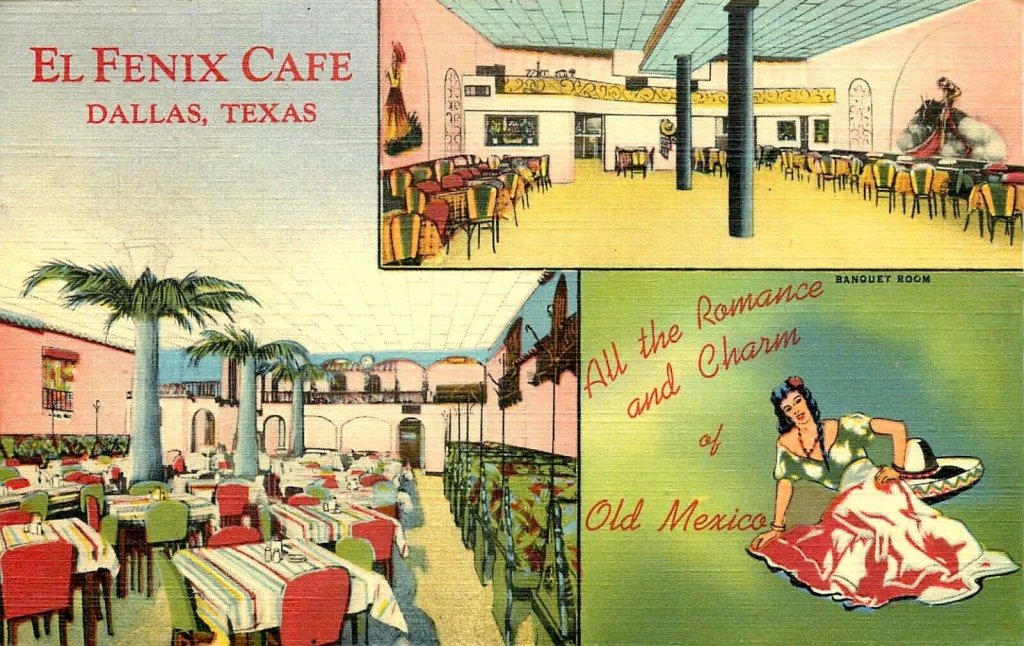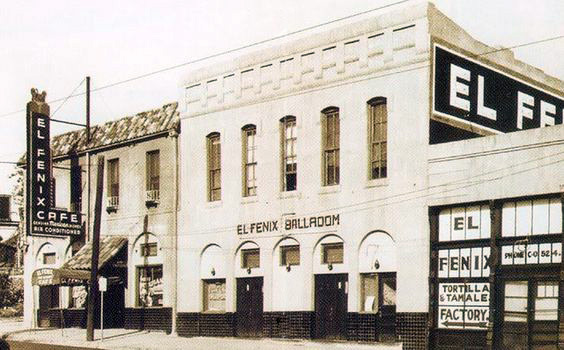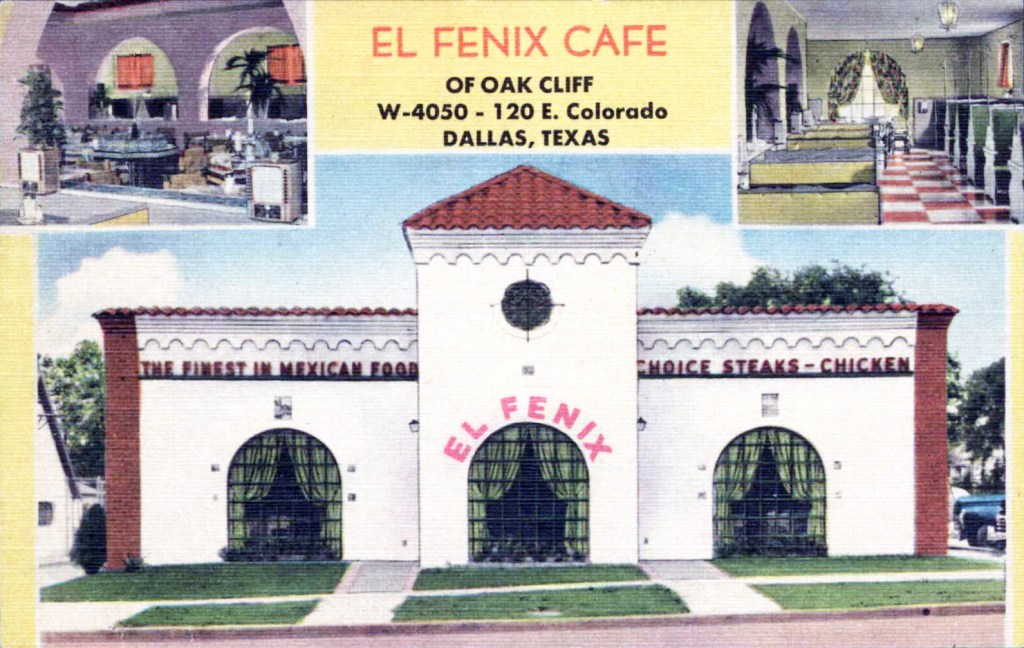In 1958, an advertisement celebrating 40 years in business made the claim that El Fenix was “The Oldest Mexican Restaurant Chain in the U.S.” According to the family of founder Miguel Martinez, he opened his first restaurant in 1918 in Dallas TX. [El Fenix on McKinney Ave. pictured above, ca. 1954]
Of course Mexican eating places, including stands, were not a new thing in Texas. They had been around throughout the 19th century in San Antonio – which of course was part of Mexico for part of that time. A Mexican man and his French wife in Los Angeles were serving tamales, enchiladas, carne con chile, and albondigas in 1881 — along with French dishes!
Martinez had come to the U.S. around 1911 during the upheaval of the Mexican revolution. Then about 21 years old, he left behind a life of hard labor that began early in childhood, with no time for school. Before opening a small café in Dallas, he had worked as a streetcar track layer, a dishwasher, cook, pool hall operator, and barber.
It’s remarkable that he was so successful in the restaurant business – where failure within five years is the norm — and that he and his family altogether carried on the business for 90 years. But I am not convinced that El Fenix was the first Mexican restaurant chain in the U.S., since its true chain development took place after WWII.
Miguel’s first café – not yet named El Fenix — was located in the center of Dallas’ “Little Mexico” barrio, a part of the city virtually abandoned in terms of city services, without paved streets, and full of poorly constructed rental properties, many of which lacked plumbing.
About seven years later, Miguel — who adopted the name Mike – moved his restaurant to a new location, in a brick building that had been a food market. Although I’ve seen earlier dates quoted, the 1926 advertisement shown here suggests it was that year that the restaurant moved to 1608 McKinney Street, an address that would be a primary location until 1965 when construction of the Woodall Rodgers Freeway necessitated moving – across the street. The name Phoenix/Fenix referred to the mythical bird associated with rebirth and survival.
By the 1930s, Mike Martinez was regarded as the big success story of Little Mexico. According to a 1931 account his restaurant had become quite popular with visiting Northerners who came to Dallas to escape cold winters and were looking for something different in the form of enchiladas and chicken mole.
Within five years he had three restaurants. In addition to the El Fenix Café on McKinney [pictured] there was an El Fenix Coffee Shop on Oak Lawn Ave. and a Mexico City Café on Pacific Ave. However, within a few years, the group was down to just one, the McKinney Street address. The manager of the Mexico City Café had bought the business and moved to a new address. About the same time, the Coffee Shop’s manager joined rival El Chico and a grocery store took over its location.
Until the mid-1940s, when Mike Martinez turned over El Fenix to his eight children, the McKinney Street location remained the sole restaurant. It had become a popular place, equipped with a large banquet room and a ballroom annex and hosting many civic and social groups. The restaurant’s owners, now the second Martinez generation, soon began to build El Fenix into a chain. [Oak Cliff location, opened 1948]
Despite the popularity of Mexican food with certain Texans and out-of-town visitors, it appears that many patrons were not fans. El Fenix, like other Mexican places, found it necessary to offer standard American restaurant fare as well. Judging from advertisements, the American menu was often promoted more actively than the Mexican, suggesting that it took a while for many Dallasites to develop a taste for Mexican food, even when it was prepared to appeal to “Tex-Mex” preferences. Although the McKinney café redecorated with a Mexican theme in the mid-1930s, the menu featured standard American restaurant fare such as steak, fried chicken, fish, and shrimp, spaghetti and meat balls, combination salads, and french fries in addition to Mexican dishes. With the end of Prohibition, it began to offer alcoholic drinks, which no doubt expanded its appeal as a dinner venue.
In 1950 the family opened the first Oklahoma City restaurant [see above advertisement], then came new locations in shopping plazas. Meanwhile, the chain also produced much of its own food for sale, including candies, tacos, tamales, and canned chili. [below, Casa Linda Plaza El Fenix, ca. 1957]
By the 1960s, Mexican dishes formed a more prominent place in El Fenix advertising, with specialties such as “crispy” puffed tortillas filled with spiced beef, chili con quezo, or fried beans. With the opening of their restaurant at Lemmon and Innwood in 1960, tagged the “most elegant Mexican restaurant in the Southwest,” an advertisement touted its fare as “the ultimate in authentic . . . extraordinary Mexican cuisine.”
The chain continued to grow. By 1984 there were 18 El Fenix-owned/franchised restaurants, 11 of them in Dallas, 4 in other Texas cities, and 3 in Oklahoma City. Two went by other names: Don Miguel’s, in Addison TX; and Taco Burrito, in Oklahoma City. [pictured above, Galleria Mall, Houston]
In 1998 newspapers reported that the other venerable Dallas chain, El Chico, was set to buy El Fenix, but the deal fell through. Ten years later El Fenix – then consisting of 15 restaurants — was sold to the Firebird Restaurant Group which continues to own it.
© Jan Whitaker, 2022
Thanks to Daniel Arreola for lending the postcard of El Fenix in Houston’s Galleria Mall.



















 It's great to hear from readers and I take time to answer queries. I can't always find what you are looking for, but I do appreciate getting thank yous no matter what the outcome.
It's great to hear from readers and I take time to answer queries. I can't always find what you are looking for, but I do appreciate getting thank yous no matter what the outcome.


